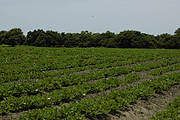Saving the topsoil, one farm at a time
11 September 2012 | Article
Around 12 million hectares of agricultural land are lost to soil erosion every year. As a result, an area of land large enough to feed all of Europe has been so severely degraded that it can no longer produce food.
Soil erosion is caused when large volumes of water run off the surface of land, causing soil, nutrients, and chemical residues to wash into waterways. Most soil erosion is a result of conventional tillage, the process farmers use to break up and turn the ground, which leaves soil more vulnerable to erosion.
Topsoil is a highly fertile and diverse ecological system that provides nutrients and water to plants, which in turn provide food and clothing for humans, feed for animals and timber for buildings. If not carefully managed, runoff and soil erosion threaten not only the productivity of these soils, but also a region’s food and water resources.
To help minimize runoff, Swiss agribusiness company Syngenta developed a set of Best Management Practices (BMPs) that minimize soil erosion and sustain crop productivity. By combining key factors, such as distance to surface water, slope and soil permeability, and erodibility, Syngenta is able to help farmers determine the local runoff and erosion risk.
“Each farm is unique,” said Romano DeVivo, Head of Sustainable Agriculture and Stewardship, Syngenta. “Because of that, the challenge is to develop tools that identify common characteristics and conservation measures that allow adaptation of BMPs to local conditions.”
In a project spanning across France, Portugal and Spain, known as the ProTerra project, soil erosion was reduced by up to 90% due to the planting of cover crops between rows of vines and olive trees on pilot farm plots.
“BMPs that reduce runoff and erosion can enhance environmental protection and also improve agricultural productivity,” said DeVivo. “The wide adoption of these measures requires local and national governments to monitor land use practice and implement soil and water body protection policies.”



